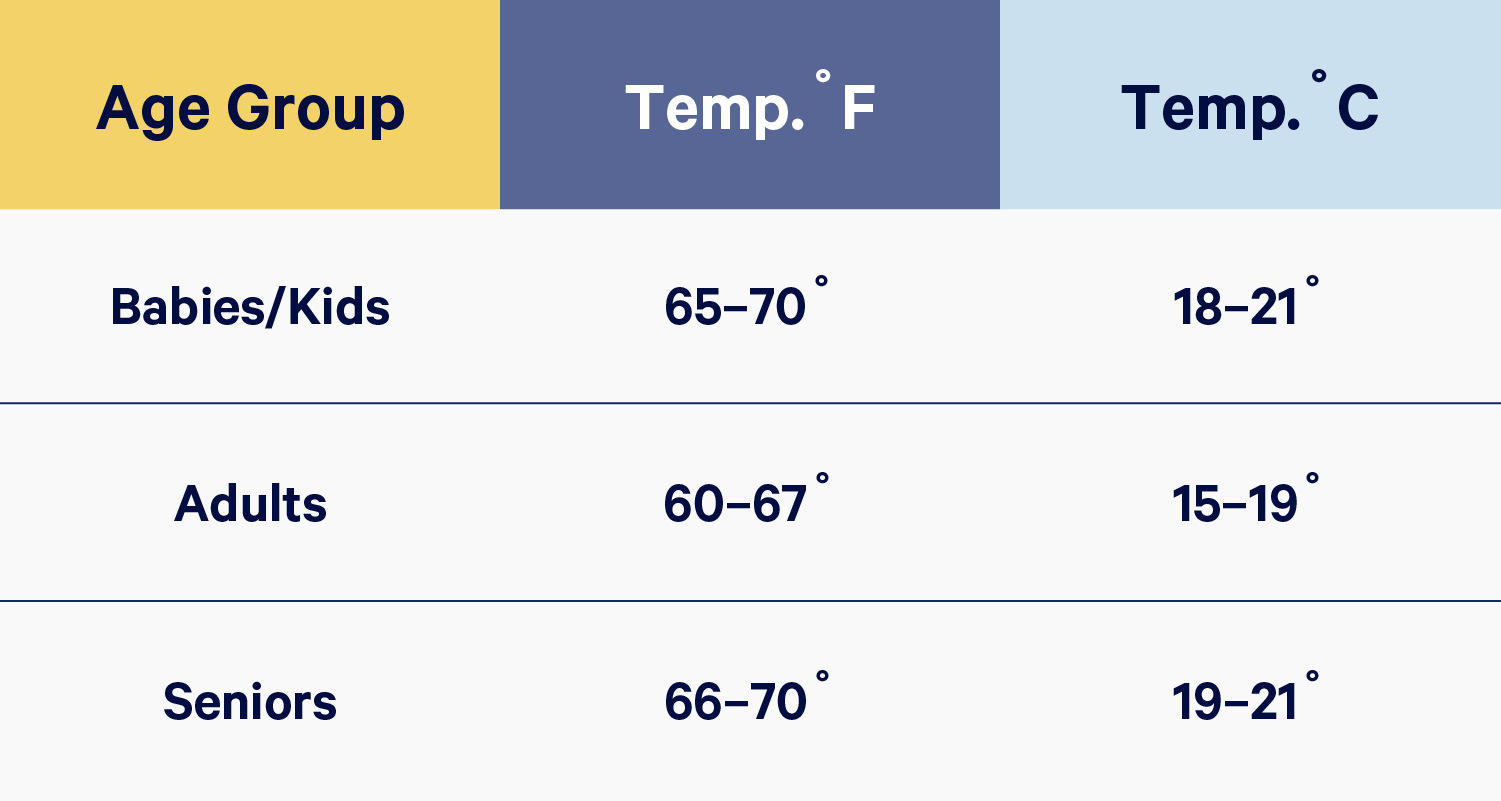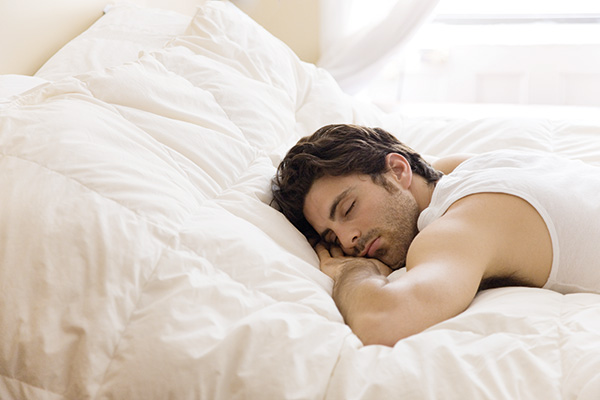Being in a comfortable environment is essential for healthy sleep. Keeping your sleeping quarters at a temperature near 65°F (18.3°C), give or take a few degrees, is ideal.
Your body’s temperature decreases during sleep, and a cool, but not cold, room will help you settle into and maintain sleep throughout the night.

Infants may need a slightly higher room temperature for sleep, but you’ll want to avoid turning up the thermometer more than a few extra degrees so their little bodies won’t get overheated.
The science
There are scientific reasons why a room temperature of around 65°F (18.3°C) is optimal for good nighttime sleep. This relates to your body’s internal temperature regulation.
Your body’s internal temperature shifts during a 24-hour period. This is known as a circadian rhythm. Your body begins to shed warmth right about the time you go to bed and continues to cool down until reaching its low point near daybreak, at around 5 a.m.
Your body cools by expanding the blood vessels in your skin. When your temperature starts to drop at night, you may notice that your hands and feet get warmer initially. This is because your body is letting heat escape through them to reduce your core temperature.
If the temperature in your sleeping environment is too hot or cold, it may affect the drop in your body’s internal temperature and cause you to have disrupted sleep.
One 2012 study found that the temperature of the room where you sleep is one of the most important factors in achieving quality sleep.
Another study looked at data from 765,000 survey respondents and found that most people experience abnormal sleeping patterns during the hotter summer months when it may be more difficult to keep sleeping quarters at an optimal temperature. This can impact the body’s ability to cool itself at night.
Does it differ for babies?
You do not need to create a vastly different sleeping environment for babies. You may consider bumping up the thermostat a degree or two, but they should be fine in a room anywhere between 60 and 68°F (15.6 and 20°C) as long as they are clothed properly.
In general, you should avoid overheating an infant because it may increase the risk of sudden infant death syndrome (SIDS).
There are several reasons infants may need to sleep in a room that’s a bit warmer than your own:
- they cannot regulate their temperatures as easily as adults
- they do not sleep with as many covers to reduce the risk of SIDS
You should put your infant to sleep in nothing more than a breathable sleeper and a sleep sack. Sleep sacks can be made out of cooler or warmer material, and you can swap them out with the seasons. Your infant should not wear a hat indoors because it affects internal body temperature and may inhibit an infant’s ability to get cool.
You can make sure your baby is not too hot by touching the back of their neck or their stomach during sleep. If their skin is hot or sweaty, remove a layer of clothing.
Your infant should also sleep in a dark and quiet environment to promote healthy sleep.
Too hot or too cold
Temperatures outside of comfortable sleeping conditions can impact your overall sleep in different ways.
Too hot
You may notice you have restless sleep when the room temperature is above the optimum sleeping temperature. This restless sleep in a hot room could be caused by a decrease in your slow wave sleep or rapid eye movement (REM) sleep.
Humidity, in addition to heat, may also contribute to sleep problems.
Too cold
A 2012 study examined semi-nude participants and found that their sleep was more affected by cold temperatures than warm ones. However, these participants did not have blankets or other bedding to stay warm.
In general, the cold will not affect your sleep cycle, but it may make it more difficult to fall asleep and impact other aspects of your health. If you’re too cold during sleep, your body may alter its cardiac autonomic response.
Other sleep tips
Good sleep is vital for your body to function well, so setting the stage for healthy sleep is very important. Here are some tips for creating an environment that contributes to quality sleep.
Regulate the room temperature
There are several ways to make sure your room stays between 60 and 67°F (15.6 and 19.4°C) at night:
- Set your home’s thermostat to drop during your sleeping hours. For example, you may keep your thermometer slightly warmer during the day, but set the thermometer cooler at night.
- Open windows or turn on air conditioning or heat if the temperature rises or falls outside of the ideal sleeping range. You may even be able to install a thermostat in your room to regulate the temperature in your sleeping quarters.
- Run an air conditioner or fan during warm months to cool the temperature and circulate the air.
Swap out bedding when the seasons change
The cozy down comforter you use in January may not be appropriate when summer hits. Keep a lightweight blanket to use on your bed during those hot months to avoid overheating.
Likewise, a bitter cold snap may require you to add another blanket on top of your comforter for a few days or weeks for more warmth.
Avoid caffeine in the afternoon or evening
Drinking caffeinated coffee, tea, or soda into the afternoon and evening may make it difficult to fall asleep at night. Instead, drink decaffeinated beverages after a certain time of day to avoid unwanted alertness when it’s time to go to bed.
Keep your room dark
Consider your bedroom a cave at night when you lie down to sleep. Cover windows with blinds or curtains to avoid streetlights or sunlight from entering your room.
You may consider removing electronic devices that emit light from your sleeping quarters as well, such as blinking lights, computer monitors, or phones.
Embrace the quiet
Your bedroom should be free from noise that may distract you from falling asleep or wake you up in the middle of the night. Keep gadgets that may buzz or beep away from your bedroom and consider a white noise machine or earplugs if you are unable to block out noises made by others.
Set a sleep routine
Your body’s circadian rhythm establishes a regular routine for your body, and you should adhere to that for healthy sleep. Try to go to bed at the same time each day.
Power down your gadgets or other blue-light emitting screens a half hour or hour before bed.
Consider reading a book or doing something calming like breathing exercises or meditation before turning off the light for the night.
The bottom line
Make sure the temperature where you sleep is on the cool side before you close your eyes at night. This will help your chances of getting a healthy and uninterrupted amount of sleep every night.
Ideally, your room should be between 60 and 67°F (15.6 and 19.4°C) for healthy sleep. Infants should also be able to sleep in these temperatures with the proper sleep attire. You may consider bumping up the temperature a degree or two for infants, but avoid letting them get too hot.


